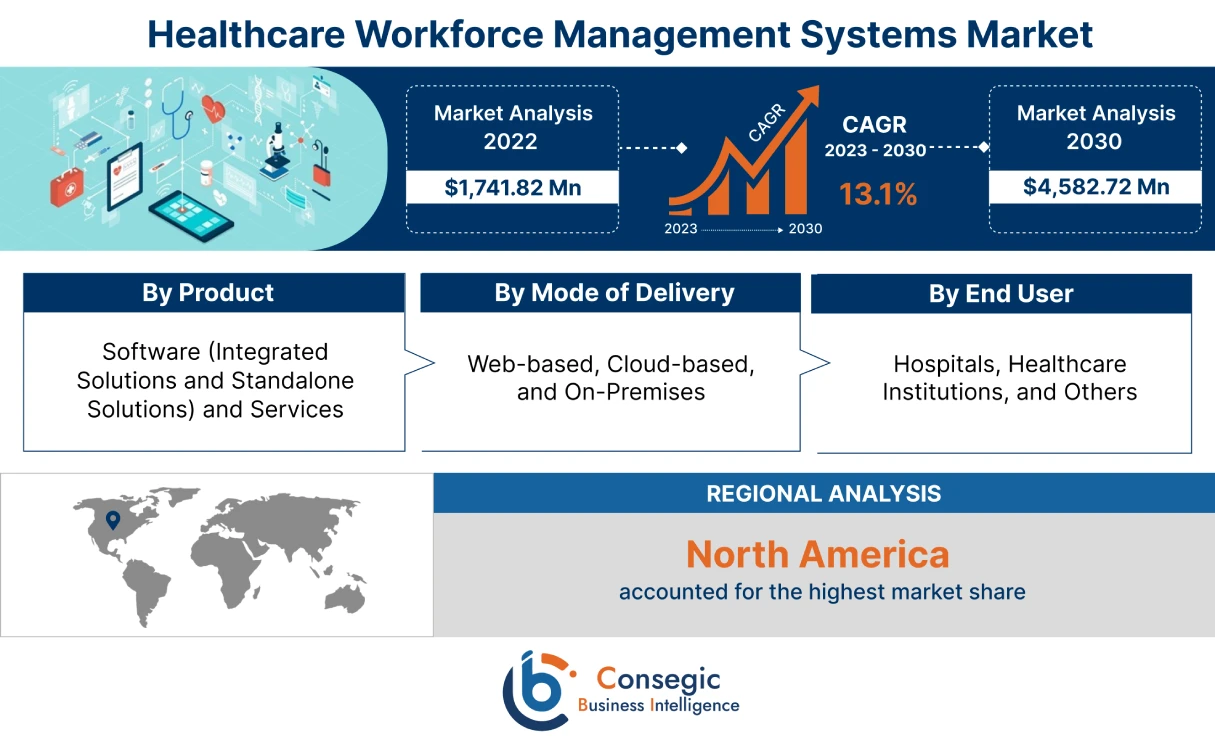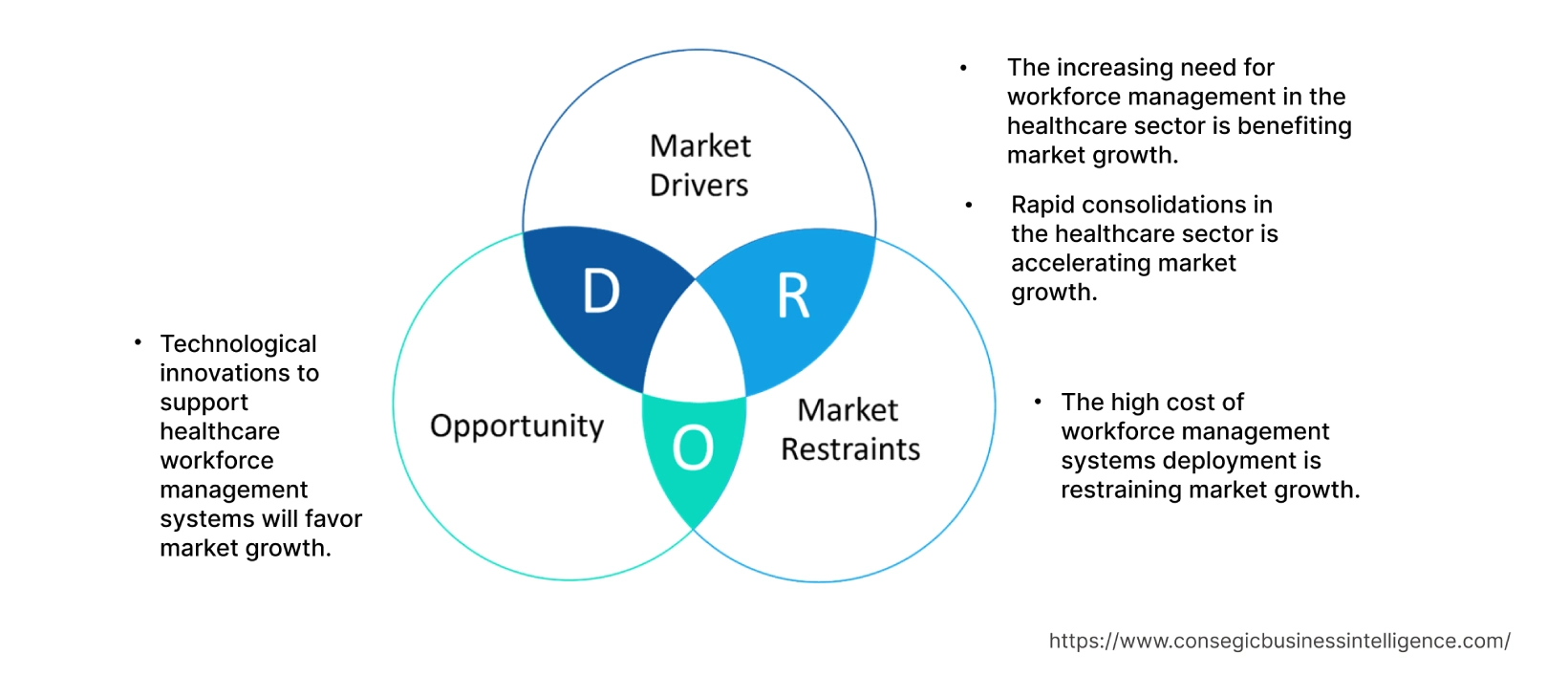Healthcare Workforce Management Systems Market Size :
Consegic Business Intelligence analyzes that the healthcare workforce management systems market size is growing with a CAGR of 13.1% during the forecast period (2023-2030), and the market is projected to be valued at USD 4,582.72 Million by 2030 from USD 1,741.82 Million in 2022.
Healthcare Workforce Management Systems Market Scope & Overview:
A healthcare workforce management system is a software or service offered to the healthcare sector to manage their workforce more effectively and efficiently. Healthcare workforce management systems help large hospitals and healthcare facilities to manage employees working hours, leaves, payroll, emergencies, schedule change, shift change, and other healthcare workforce-related problems.
In addition to these several advantages of healthcare workforce management systems, this tool can also perform significant functions such as managing payrolls, filling up open positions, and monitoring the workforce to ensure optimum productivity. Moreover, various features of workforce management systems such as biometric time clocks, web-based interface, or mobile applications the system ensures precise clock-in and clock-out times are used in the healthcare sector for the effective and efficient management of the workforce.
Healthcare Workforce Management Systems Market Insights :
Healthcare Workforce Management Systems Market Dynamics - (DRO) :
Key Drivers :
The increasing need for workforce management in the healthcare sector is benefiting market growth
Healthcare workforce management systems are used to automate and simplify the process of workforce management across the healthcare sectors. Unlike other industries, the healthcare sector might have flexible shift hours based on medical emergencies like accidents, gunshot victims, women going into labor, incidents of heart attacks and cardiac arrests, and so on often forcing doctors and nurses to stay back to attend to the patients. In such cases managing a large workforce across the healthcare sector becomes very difficult to manage. Workforce management systems in healthcare allow human resources or senior management to keep track of employee activities and govern better. An increasing number of employments in healthcare occupations is driving the demand for healthcare workforce management systems globally. For instance, according to the report by the United States Census Bureau in October 2020, the total employment in the healthcare sector increased from 2.3 million in 2017 to 130.9 million in 2018. Furthermore, according to the report by the U.S. Bureau of Labor Statistics (BLS) in September 2022, overall employment in healthcare occupations is projected to grow 13% from 2021 to 2031. Hence, this growing employment in the healthcare sector is leading to difficulty in managing the workforce and boosting the demand for healthcare workforce management systems to ensure efficient management of the workforce. This, in turn, is benefiting the market growth.
Rapid consolidations in the healthcare sector is accelerating market growth
Consolidation in the healthcare sector includes the merger of hospitals, integration of hospitals and insurance companies with large physician practitioners, and expansion of hospital systems across multiple states and geographical regions. Consolidation in the healthcare sector often leads to the formation of a larger and more complex organization. Healthcare workforce management systems offer several benefits such as fulfilling labor demand, channelizing work schedules, realizing material requirements, tracking attendance, and boosting workforce efficiency. This increasing consolidation by the various healthcare operators across the globe is increasing the demand for healthcare workforce management systems. For instance, in April 2022, the Centers for Medicare & Medicaid Services released data regarding the consolidations in the healthcare sector from a period of 2016 to 2022 for hospitals and nursing homes, 19% of the hospitals during the period were sold in South Carolina state and, 62.3% of Skilled Nursing Facilities (SNFs) were purchased by single organizational owners.
Hence, the high consolidation rate in the healthcare sector is accelerating the demand for healthcare workforce management systems as an essential tool for handling workforce-related data and payrolls in the healthcare sector. This, in turn, is driving the growth of the market.
Key Restraints :
The high cost of workforce management systems deployment is restraining market growth
A healthcare workforce management system is a specialized software solution designed to streamline and optimize various aspects of staffing and optimizing management within healthcare. This system helps healthcare providers efficiently manage their workforce, from scheduling and time tracking to staff allocation and task assignments. As healthcare- organizations strive to optimize staff scheduling, improve patient care, and enhance operational efficiency, the adoption of these systems becomes essential. However, the substantial expenses related to implementing, customizing, and maintaining these systems deter many healthcare providers, particularly smaller facilities with limited budgets, from fully embracing the technology. These financial burdens hamper the expansion of the market, preventing border access to the benefits of streamlined workforce management and ultimately impeding the overall potential of the global healthcare workforce management system market.
Future Opportunities :
Technological innovations to support healthcare workforce management systems will favor market growth
Healthcare workforce management systems are an ideal solution for hospitals to manage the activities of doctors, nurses, and other administrative staff. Healthcare workforce management systems are also useful in the management of workers' time, organizing and deploying their labor force efficiently, enabling employee and manager self-service, and other benefits across the sector. Various key players involved in the global healthcare workforce management systems market are focusing on the launch of technologically innovative healthcare Workforce Management systems, which is expected to create lucrative growth opportunities for the growth of the global healthcare workforce management systems market. For instance, in June 2023, Strata Decision Technology, a company involved in the development of cloud-based financial planning, analytics, and performance tools for healthcare, announced the launch of a Real-Time Workforce Management (RTWM) solution, to address the financial and operational goals of the healthcare sector. Hence, technological innovations in healthcare workforce management systems are creating lucrative growth opportunities for the global healthcare workforce management systems market.
Healthcare Workforce Management Systems Market Report Insights :
| Report Attributes | Report Details |
| Study Timeline | 2017-2030 |
| Market Size in 2030 | USD 4,582.72 Million |
| CAGR (2023-2030) | 13.1% |
| By Product | Software (Integrated Solutions and Standalone Solutions) and Services |
| By Mode of Delivery | Web-based, Cloud-based, and On-Premises |
| By End User | Hospitals, Healthcare Institutions, and Others |
| By Region | North America, Europe, Asia-Pacific, Latin America, and Middle East & Africa |
| Key Players | IBM Corporation, Infor, Inc., Oracle Corporation, Kronos, Inc., McKesson Corporation, OSP Labs, GE Healthcare, Cornerstone OnDemand, Inc., Strata Decision Technology, L.L.C. and, QGenda, LLC |
Healthcare Workforce Management Systems Segmental Analysis :
By Product :
The product segment is categorized into software and services. In 2022, the software segment accounted for the highest market share in the overall healthcare workforce management systems market and is expected to grow at the fastest CAGR over the forecast period. The software segment includes integrated solutions and standalone solutions. Healthcare workforce management systems software helps the healthcare sector to effectively monitor and track staff attendance along with their schedule and workflow. Furthermore, healthcare workforce management systems also have effective appointment booking software that helps hospitals manage appointments based on availability. The increasing launches of new and advanced healthcare workforce management software systems are driving market growth. For instance, in December 2022, QGenda, a leading provider of healthcare workforce management solutions, announced the launch of QGenda Nurse and Staff Workforce Management System, a mobile-first solution that makes it accessible to deploy and manage the healthcare workforce. These new solutions provide healthcare-specific applications for scheduling, time and attendance, compensation management, and workforce analytics. Thus, due to the above beneficial properties, the deployment of healthcare workforce management software systems across the healthcare sectors ensures superior benefits, which, in turn, is benefiting the market growth.
By Mode of Delivery :
The mode of delivery segment is categorized into web-based, cloud-based, and on-premises. In 2022, the cloud-based segment accounted for the highest market share in the overall healthcare workforce management systems market and is expected to grow at the fastest CAGR over the forecast period. The high benefits of cloud-based healthcare workforce management systems are the major factors leading to the dominance of the segment in the base year. Cloud-based delivery in the healthcare sector provides benefits such as low set-up cost, lower cost of IT maintenance, elimination cost of software updates, and provides the advantage of flexibility and adaptability in workforce management systems. Various companies worldwide are focusing on the launch of cloud-based workforce management systems for the healthcare industry, which is a major factor driving the segment growth. For instance, in April 2023, Workday, Inc., a leader in enterprise cloud applications for finance and human resources, announced the expansion of their cloud-based workforce management system for the healthcare industry. Various healthcare organizations globally such as Jefferson Health, Northeast Georgia Health System, Terrebonne General Health System, and Whitman Hospital & Medical Clinics (WHMC) have adopted Workday Financial Management, Workday Human Capital Management (HCM), and Workday Supply Chain Management (SCM) as their workforce management systems. Such increasing adoption of cloud-based healthcare workforce management systems across the globe is benefiting market growth.
By End-User :
The end user segment is categorized into hospitals, healthcare institutions, and others. In 2022, the hospital segment accounted for the highest market share of 52.50% in the healthcare workforce management systems market. Healthcare workforce management systems are employed in various hospitals to improve workforce productivity and efficiency across the hospitals. These systems provide various benefits in hospitals for tracking employee shift timing, efficient payroll management, following regulatory compliances, and managing human resources at hospitals. Owing to these high benefits, it is increasingly getting popular across hospitals. For instance, in May 2023, RLDatix, a healthcare technology solution provider, announced a partnership with Nashville General Hospital (NGH), which is a public hospital in Nashville, Tenn. As per the partnership, RLDatix implements its entire suite of solutions across the governance, risk, compliance, and workforce management portfolio at the Nashville General Hospital (NGH). By integrating RLDatix solutions, NGH will streamline and generate operational efficiencies, particularly related to workforce and risk management initiatives. This increasing focus of hospitals on the successful integration of workforce management systems is benefiting the segment's growth.
However, the healthcare institutions segment is expected to be the fastest-growing segment during the forecast period. Healthcare institutions are composed of ambulatory surgical centers, birth centers, blood banks, clinical and medical offices, diabetes education centers, and others. The increasing number of healthcare institutions across the globe is spurring the demand for healthcare workforce management systems from healthcare institutions.
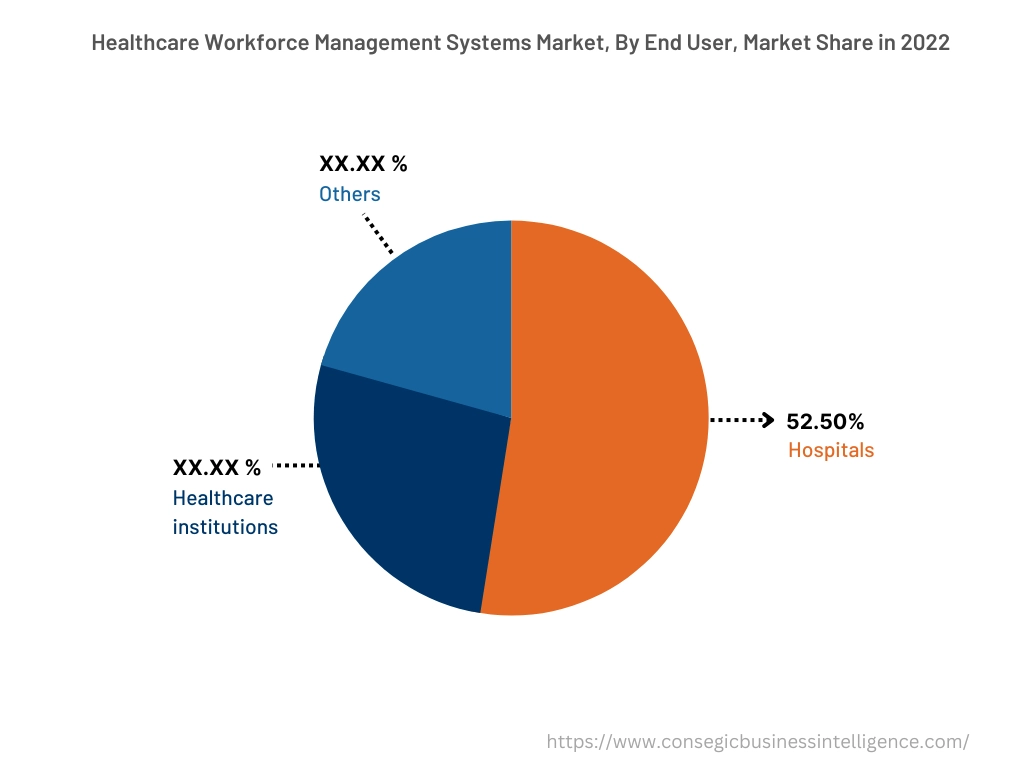
By Region :
The regional segment includes North America, Europe, Asia Pacific, Middle East and Africa, and Latin America.
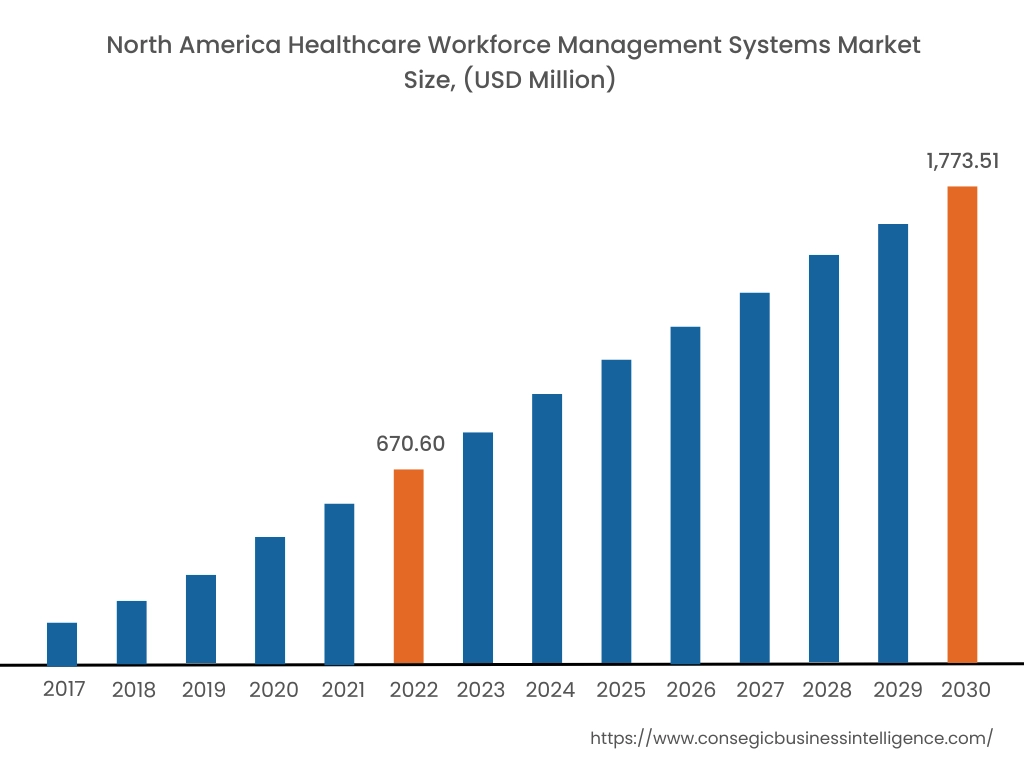
In 2022, North America accounted for the highest market share at 38.50% and was valued at USD 670.60 million and is expected to reach USD 1,773.51 million in 2030. In North America, the U.S. accounted for the highest market share of 68.55% during the base year of 2022. The major factor driving the market growth across the region is the high presence of large key players such as IBM, Oracle Corporation, Kronos Incorporated, and others in the region. Furthermore, increasing investments in the development of healthcare workforce management systems across the region are driving market growth across the North American region. For instance, in February 2023, ShiftMed, a healthcare staffing solution provider, announced that it has raised USD 200 million from the healthcare investors, Panoramic Ventures for the expansion of ShiftMed's healthcare workforce management systems solutions across the region. Henceforth, the increase in the above investment for the development and launch of healthcare workforce management systems along with the high presence of global key players in the North America region is proliferating the growth of the market.
Furthermore, Asia Pacific is expected to witness significant growth over the forecast period, growing at a CAGR of 13.9% during 2023-2030. This is due to the increasing economic growth, significant growth in the IT sector across the region, and advancement in healthcare IT in the region.
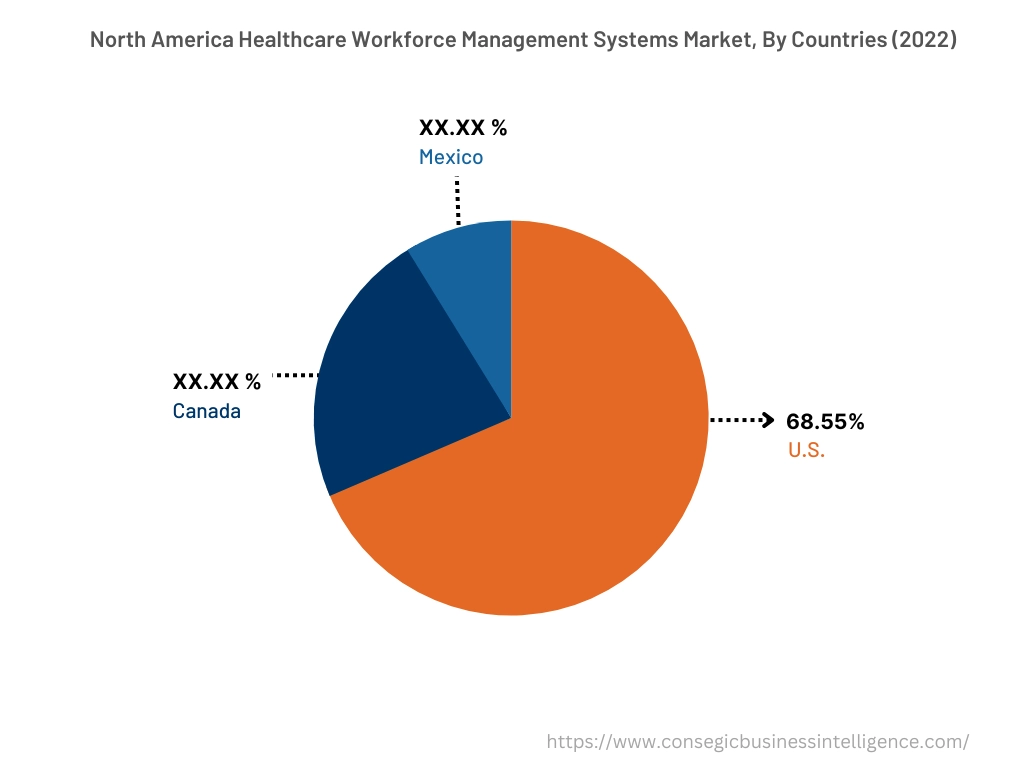
Top Key Players & Market Share Insights:
The healthcare workforce management systems market is highly competitive, with several large players and numerous small and medium-sized enterprises. These companies have strong research and development capabilities and a strong presence in the market through their extensive product portfolios and distribution networks. The market is characterized by intense competition, with companies focusing on expanding their product offerings and increasing their market share through mergers, acquisitions, and partnerships. The key players in the market include-
- IBM Corporation
- Infor, Inc.
- Cornerstone OnDemand, Inc.
- Strata Decision Technology, LLC
- QGenda, LLC
- Symplr
- Oracle Corporation
- Kronos, Inc.
- McKesson Corporation
- OSP Labs
- GE Healthcare
Recent Industry Developments :
- In January 2023, ShiftMed, a healthcare staffing solutions provider, announced a partnership with UKG, which is an HR, payroll, and workforce management solution provider for the launch of new technology for healthcare workforce management.
- In March 2022, QGenda, a healthcare workforce management solution provider announced the launch of its operations platform, ProviderCloudTM. This new platform allows healthcare organizations of all sizes to gain holistic visibility into their entire workforce, as well as the actionable data that providers need to deliver quality patient care when and where it is needed.
- In August 2020, Kronos, Inc.'s subsidiary Smart EFM announced the launch of a new healthcare division, which aimed to help healthcare organizations modernize their workforce practices.
Key Questions Answered in the Report
What was the market size of the healthcare workforce management systems industry in 2022? +
In 2022, the market size of healthcare workforce management systems was USD 1,741.82 million
What will be the potential market valuation for the healthcare workforce management systems industry by 2030? +
In 2030, the market size of healthcare workforce management systems will be expected to reach USD 4,582.72 million.
What are the key factors driving the growth of the healthcare workforce management systems market? +
Increasing need for workforce management in the healthcare sector is benefiting market growth.
What is the dominating segment in the healthcare workforce management systems market by end user? +
In 2022, the hospitals segment accounted for the highest market share of 52.50% in the overall healthcare workforce management systems market.
Based on current market trends and future predictions, which geographical region is the dominating region in the healthcare workforce management systems market? +
North America accounted for the highest market share in the overall healthcare workforce management systems market.
